|
|
 |
Australia
The early years
This page is dedicated to the Haflinger history in Australia. It is definitely interesting to have a close look at the smallest continent, as a lot of vehicles were exported there. The very first Haflinger
was brought to Australia in 1959 by a company called Moffat Virtue in Sydney. Possibly, Steyr-Puch had the intention to sell vehicles to the Australian Army, but it seems more interest was attracted
in the civilian sector. For this reason, a company
called "Anti-Friction Bearings Ltd." (A.F.B.) in Melbourne decided to become Australia's agent for the Haflinger in 1962. In the next years - especially 1963 and 1964 - quite a lot of Haflingers
could be sold on the civilian market.
Diese Seite ist der Haflinger-Geschichte in Australien gewidmet. Viele Fahrzeuge wurden dorthin geliefert, und bieten interessanten Stoff für eine Dokumentation! Der erste Haflinger wurde
1959 nach Australien exportiert und an eine Firma namens Moffat Virtue in Sydney geliefert. Steyr-Puch hatte wahrscheinlich die Absicht, Fahrzeuge an die Australische Armee zu verkaufen, woraus
aber vorerst nichts wurde. Stattdessen kam Interesse von Seiten
des zivilen Marktes auf. Deshalb übernahm eine Firma Namens "Anti-Friction Bearings Ltd." (A.F.B.) in Melbourne 1962 die Vertretung für den Haflinger. In den nächsten
Jahren (vor allem 1963 und 1964) konnten einige Haflinger am zivilen Markt verkauft werden.
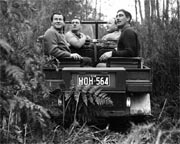
|
Here is a historic picture with an early Haflinger with raised air vent. According to Mr. Hirschmann, who gave me the photo, the man with moustache on the right side is Peter Coke, who was
also involved in the Haflinger sales together with Barry Jones (see further below). Does anyone know something about the people in the Haflinger and about the Haflinger itself?
Links zu sehen ist ein Archivbild, das einen frühen Haflinger zeigt (ebenfalls mit dem hochgezogenen Luftschacht). Der Mann ganz rechts ist Peter Coke, der zusammen mit Barry
Jones (siehe weiter unten) auch in den Handel mit Haflingern involviert war. Weiß jemand mehr über die abgebildeten Herren oder über den Haflinger?
|
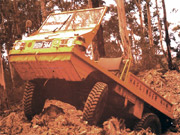
|
This is a younger picture of the same Haflinger. According to John Callahan, who also owned this vehicle, this is the first Haflinger that was brought to Australia by A.F.B. in 1962. Note that this Haflinger
is not a proper tropical version yet, but has the cyclone filter fitted on the side panel of the front nose. This appears to be the experimental stadium of the tropical Haflinger. Is there anyone
who could come up with more information about the remain of this vehicle? Thanks John Callahan for the picture.
Dieses jüngere Foto zeigt den selben Haflinger. John Callahan, der das Fahrzeug einmal besessen hat, meint, dass dies der erste Haflinger war, der von A.F.B. importiert wurde (1962). Man beachte den
Zyklonluftfilter, der seitlich auf der Front montiert ist. Es handelt sich um eine frühe, experimentelle Version des Tropenhaflingers. Wer weiß mehr über den Verbleib
des Haflingers? Danke John Callahan für das Bild.
|
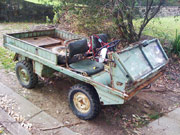
|
What you see here is a January-1963 Haflinger, again one of the first ones that have been exported to Australia. Note that the vehicle has no tropical air intake yet, which was
common on later Hafs.
Hier abgebildet ist ein früher 1963er Haflinger. Es handelt sich auch hierbei um eines der ersten Fahrzeuge in Australien - noch ohne Tropenluftfilter, der
später Standard war.
|
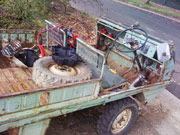
|
Note also the early side boards design and the PTO (no rear seat box on the right side). Power take off was a very popular option in Australia, also on younger vehicles.
Man beachte auch die frühen Bordwände und den Nebenantrieb (keine Fußwanne rechts hinten). Der Nebenantrieb wurde in Australien oft bestellt, auch bei jüngeren Haflingern.
|
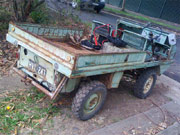
|
The rear engine door design would be correct for a Haflinger with the raised air vent, so maybe the air vent is gone on this Haflinger or the door was changed somewhen. Thanks to Rick Krassoi
for the pictures.
Der Haflinger dürfte einmal mit dem hochgezogenen Luftschacht ("Rucksack") ausgestattet gewesen sein. Vielleicht wurde er irgendwann abmontiert.
|
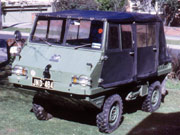
|
This picture shows a lovely 1963 Haflinger with long canvas top, formerly owned by John Wood. This vehicle already has the tropical air intake system with the cyclone filter mounted on the front.
Typical for this time are also front and rear bumpers, which you can see on the photos.
Dieses Bild zeigt den ehemaligen, schönen Haflinger Bj. 1963 von John Wood mit langem Verdeck. Das Fahrzeug ist schon mit dem Tropenluftfilter auf der Front ausgestattet.
Typisch für dieses Baujahr sind auch die Stoßstangen vorne und hinten.
|

|
Like some other Haflingers from this period that I have seen so far, this one is equipped with Swiss Army tail lights and also with the corresponding support panel. This is possibly the case, because
at this time, the Swiss tail light solution was the only one with yellow indicators. In Austria, Haflingers would still have red indicators.
Wie einige weitere Haflinger aus dieser Zeit, ist dieser mit den Heckleuchten der Schweizer Armee ausgestattet (plus Aufnahmeblech). Dies ist wahrscheinlich deswegen der Fall, weil
die Leuchten einen gelben Blinker haben. In Österreich wurden damals noch rote Blinker verbaut.
|
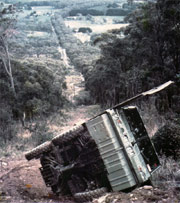
|
Here you see the beautiful Haflinger on its side on a track near Mount Dandenong, close to Melbourne. Thanks John Wood for the pictures.
Hier ein Bild mit dem Haflinger auf einem Weg am Mount Dandenong in der Nähe von Melbourne.
|
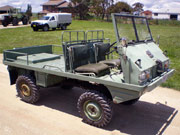
|
Shown to the left is another very nice and original Haflinger from 1963. Interestingly, this Haflinger already has the raised cargo guard plates. Also interesting are the tactical sign holders on the
front (and on the back), which are usually only seen on Australian Army Haflingers (see further below). Maybe this vehicle was used as a demonstrator.
Linkerhand ein weiterer schöner, originaler Haflinger Bj. 1963. Interessant sind die Halterungen für taktische Zeichen, die man sonst nur von Australischen Armeehaflingern kennt
(siehe weiter unten). Vielleicht wurde das Fahrzeug als Vorführer benutzt.
|
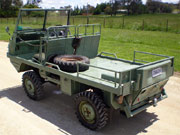
|
On this picture, you can see the raised air vent very well. It prevents the engine room from being polluted in dusty areas. Again you can see the Swiss tail light configuration.
For some reason, this Haflinger has no rear footwell on the left side, maybe it was removed.
Auf diesem Foto sieht man den hochgezogenen Luftschacht sehr gut. Er beugt in staubigen Gebieten gegen Verschmutzung im Motorraum vor. Wieder zu sehen sind die Schweizer
Armee Rückleuchten. Die linke hintere Fußwanne dürfte entfernt worden sein.
|
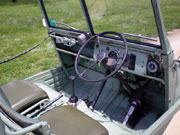
|
Note the hour meter on the right side of the dashboard. This can often be seen on Australian Haflingers.
Man beachte den Betriebsstundenzähler rechts vom Armaturenbrett. Dieser war in Australien weit verbreitet.
|
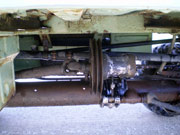
|
This Haflinger has an original support on the central tube with a double v-belt pulley, which is driven by the PTO. Additional equipment on the cargo area could be driven via a belt through the
longish lid just above the pulley. Thanks Robert Williams for the pictures.
Dieser Haflinger hat auch den Nebenantriebsbock mit Riemenscheibe am Zentralrohr. Durch den Deckel in der Ladefläche kann ein Riemen zum Antrieb von Zusatzaggregaten auf der
Ladefläche geführt werden.
|
Australian Army Haflinger
1966 proved to be an important year in the Australian Haflinger history, as the Australian Army ordered 50 vehicles. To fulfill their needs, Steyr-Puch build a very specific Haflinger version,
which is described more detailed on its own Australian Army Haflinger page. However, I'd still like to show some basic pictures:
1966 war ein wichtiges Jahr für die Haflinger-Geschichte in Australien: Die Australische Armee bestellte 50 Fahrzege. Um deren Wünschen nachzukommen, baute Steyr-Puch
eine spezielle Haflingerversion, die auf einer eigenen Seite detailliert beschrieben ist. Anfolgend ein paar grundlegende Fotos:
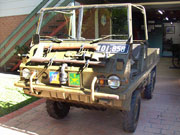
|
Typical are the tool holders on the front and the tactical sign holders on the fresh air flaps. The Army Haflingers are also equipped with PTO, but they still have two rear seat boxes.
The PTO was thought to be used for a hydraulic pump to lift/lower floating pontoons that could be fitted to both sides of the Haflinger. Only a few vehicles had this equipment.
Typisch sind die Halterungen für Schanzzeug auf der Front und die Halterungen für taktische Zeichen auf den Frischluftklappen. Die Haflinger sind mit Nebenantrieb
ausgestattet, jedoch sind trotzdem zwei Sitze hinten vorhanden. Der Nebenantrieb war dafür gedacht, eine Hydraulikpumpe anzutreiben, mit der man Pontons zum Schwimmen
heben und senken konnte. Nur wenige Fahrzeuge hatten diese Ausrüstung.
|
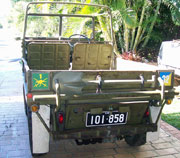
|
An original Steyr-Puch hitch was standard on these Haflingers. They also came with a raised air vent, but a different type that does not go all the way up to the rear board. The same design
was e.g. also used on Kommunalhaflingers. Indicators and rear lights are original on this Haflinger. The white mud guards are not original. Thanks Peter Derges for the pictures.
Eine originale Steyr-Puch Anhängekuppung war Standard bei diesen Haflingern. Man findet wieder den Luftschacht, jedoch eine andere Ausführung, die nur bis zur
hinteren Randversteifung reicht (so wie bei vielen Kommunalhaflingern). Die gelben Blinker sind original, jedoch nicht die weißen Schmutzfänger.
|
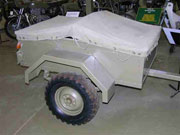
|
An Australian made trailer makes the set complete. They were also fitted with Haflinger tyres.
Ein in Australien gefertigter Anhänger komplettiert das Gespann. Diese Anhänger wurden auch mit Haflinger-Reifen ausgestattet.
|
Assembling in Australia
In 1966, the sales level was high enough to justify an assembly of CKD kits in Australia. CKD stands for "completely knocked down". The vehicles were built at the Steyr-Puch
factory at Graz in Austria. After production, they were again partially disassembled and packed into wooden crates, which were then sent to Australia for local assembly. In this way, less
import duty had to be paid - but a local assembly line had to be set up. This was done by Anti-Friction Bearings at Clayton, Victoria. Up to 30 Haflingers could be assembled there
per month.
1966 waren die Verkaufszahlen hoch genug, um eine CKD-Assembling-Linie rechtzufertigen. CKD steht für "completely knocked down". Die Fahrzeuge wurden bei Steyr-Puch
in Graz gebaut, dann wieder teilweise zerlegt und in Holzkisten verpackt. Diese "CKD-Kits" wurden dann nach Australien verschickt, um dort vor ort assembliert zu werden.
So ergaben sich Vorteile beim Einfuhrzoll, jedoch musste lokal eine Produktionslinie errichtet werden. Anti-Friction Bearings tat das an einem Standort in Clayton in Victoria. Bis zu 30 Haflinger
konnten pro Monat zusammengebaut werden.
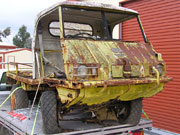
|
Here you see a 1968 Series 2 Haflinger that was assebled in Australia. Note the white cabin, which was locally made and used to be the Australian "Polycab". There would also come
special doors with it. The cabin was based on the original roll bar and hood sticks, as you can see further below.
Hier abgebildet ist ein Serie 2 Haflinger Bj. 1968, der schon in Australien zusammengebaut wurde. Man beachte das Fahrerhaus, das in Australien produziert wurde (das "Australische
Polyesterhaus"). Es gab auch eigene Türen dafür. Für das Fahrerhaus wurde das originale Planengestänge herangezogen (siehe weiter unten).
|
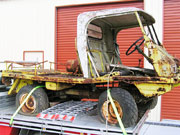
|
Note the early Series 2 rear light assembly, which was equipped with Carello lights for some reason. You can also see that this Haf has a power take off and no right seat box. Another interesting
feature are the tyres: These are Semperit tyres with "diamond tread" on widened 7 inch Haflinger rims, a quite popular option in Australia. Thanks Gerald Madeley for the photos.
Man beachte die frühen Serie 2 Rücklichter (mit Carello-Leuchten). Man kann wiederum sehen, dass der Haflinger einen Nebenantrieb und keinen rechten hinteren Sitz hat.
Interessant sind auch die Semperit Reifen mit "Diamant-Profil" auf verbreiterten 7 Zoll Haflingerfelgen - eine Option, die man in Australien recht oft sieht.
|
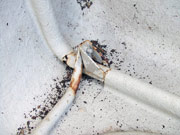
|
This picture shows a close-up of the Australian made cabin. You can see well that it was formed around the original Haflinger hoodsticks.
Dieses Bild zeigt eine Nahaufnahme des Australischen Fahrerhauses. Man sieht gut, dass es um das originale Planengestänge herum gebaut wurde.
|
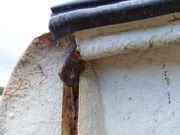
|
This is the front end that connects with the windscreen frame. You can imagine that the fiberglass wrapped around the hoodsticks is a nest for corrosion...
Hier das vordere Ende, das am Scheibenrahmen montiert wird. Die Umhüllung des Gestänges ist leider ein schönes Nest für den Rost...
|
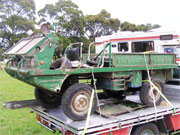
|
Here you see another 1968 Haflinger, this one without PTO. Note the roll bar: It is cut off, but you can still see that is is yet the version without mounting points for safety belts. Thanks Gerald
Madeley for the picture.
Hier ein weiterer Haflinger Bj. 1968, diesmal ohne Nebenantrieb. Man sieht noch die Reste des Überrollbügels, noch die Ausführung ohne Aufnahmen für Gurte.
|
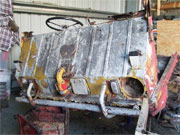
|
This poor friend will possibly never be on the road again, having sat outside and been neglected for too long. But still there are some interesting things to discover.
Dieser arme Haflinger wird wahrscheinlich nie mehr auf der Straße zu sehen sein, aber dennoch gibt es ein paar interessante Dinge zu entdecken.
|
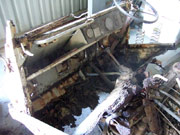
|
Note for example again the popular engine hour meter. On Series 2 Haflingers, they were usually mounted in an additional box in the glovebox to the left of the dashboard.
Man beachte z.B. wiederum den Betriebsstundenzähler. Bei Serie 2 Haflingern war er in der Regel in einer eigenen Aufnahme links vom Armaturenbrett montiert.
|
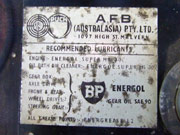
|
Here you see a close-up of the bright tag on the dashboard: A recommendation for lubricants by Anti-Friction Bearings Ltd. Thanks Rick Krassoi for the photo session.
Hier sieht man eine Nahaufnahme des hellen Aufklebers am Armaturenbrett: Eine Empfehlung von A.F.B. für Schmiermittel.
|
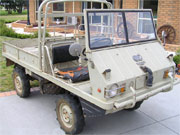
|
This picture shows a slightly younger Haflinger from 1970. Note the original paint: This beige was very common on Series 2 Haflingers in Australia. Even though many vehicles have been repainted,
you will still find this beige somewhere underneath in most cases. Thanks Gerald Madeley for the picture.
Dieses Foto zeigt einen etwas jüngeren Haflinger, Bj. 1970. Man beachte den originalen Lack: Das Beige war sehr verbreitet bei Serie 2 Haflingern in Australien. Obwohl viele Fahrzeuge
überlackiert wurden, findet man doch meistens noch das Beige darunter.
|
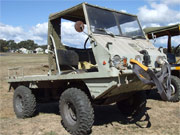
|
Another nice and original 1970 Haflinger with power take off. Again you find the wide 7" rims.
Ein weiterer schöner, originaler Haflinger Bj. 1970 mit Nebenantrieb. Wiederum sieht man die verbreiteten 7" Felgen.
|
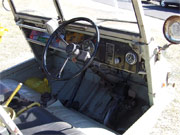
|
In this case, the hour meter is mounted on the right side of the dashboard again. Thanks Rick Krassoi for the photo session.
Bei diesem Haflinger ist der Betriebsstundenzäher wieder rechts vom Armaturenbrett montiert.
|
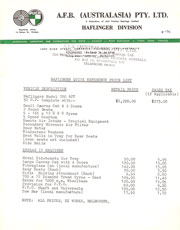
|
Here you see a price list from A.F.B., dated 4-1970. It's always interesting to see how much a Haflinger and all the extras would have cost at that time!
Hier eine Preisliste von A.F.B. vom April 1970. Es ist immer wieder interessant zu sehen, wie viel ein Haflinger zu jener Zeit gekostet hätte.
|
Haflinger Sales & Service
In 1968, A.F.B. was taken over by a company called Ransome Hoffman Pollard Australia Ltd. In 1972, Mr. Barry Jones, who was the managing director of the Haflinger division, decided to
buy the subsidiary from Ransome Hoffman Pollard and moved the Haflinger assembly line from Clayton to Booloora Road in Springvale. He called his new company "Haflinger Sales
and Service Pty Ltd.". In the best times, eight assembly line workers, two repair mechanics and two field assistents were employed.
1968 wurde Anti-Friction Bearings von einer Firma Namens Ransome Hoffman Pollard Australia Ltd. übernommen. 1972 entschied sich Barry Jones, damals Leiter der Haflinger-Sparte,
die Tochterfirma von Ransome Hoffman Pollard zu kaufen. Er übersiedelte die Assembling-Linie von Clayton nach Springvale. Die neue, eigene Firma taufte er "Haflinger Sales and
Service Pty Ltd.". Zu den besten Zeiten waren acht Produktionsmitarbeiter, zwei Mechaniker und zwei Außendienst-Mitarbeiter angestellt.
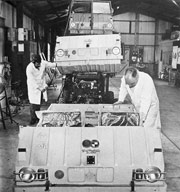
|
Here you see a lovely picture of the Haflinger assebly line in Springvale. The photo is taken from an interesting article in the Overlander magazine edition 10/1977.
Hier ein tolles Bild von der Haflinger-Produktionslinie in Springvale. Das Foto stammt aus einem interessanten Artikel im "Overlander" Magazin 10/1977.
|
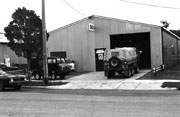
|
This is the same production hall seen from outside. You can see that the Pinzgauer was also already involved when this picture was taken. Thanks Mr. Hirschmann for the picture.
Dieses Foto zeigt die Produktionshalle von außen. Man sieht, dass es der Pinzgauer hier auch schon nach Australien geschafft hatte.
|
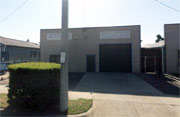
|
If you look out for 22 Booloora Road, Springvale, Victoria on Google Maps and/or Google Street View, you can find the same site quite untouched today!
Wenn man 22 Booloora Road, Springvale, Victoria bei Google Maps bzw. bei Google Street View sucht, findet man die Produktionshalle noch immer relativ unberührt vor!
|
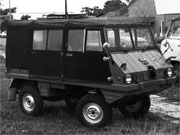
|
Close-up of the Haflinger shown two pictures above. Note the interesting front cross member! Also, the rear footwell has no rib and doesn't look original. Thanks Mr. Hirschmann for the picture.
Hier eine Aufnahme des Haflingers, der auch zwei Fotos weiter oben gezeigt wird. Interessant ist die abgeänderte vordere Randversteifung. Auch die hintere Fußwanne sieht komisch
aus (keine Sicke).
|
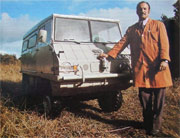
|
Here you see Barry Jones and his LWB Haflinger. Note the full hard top, which was locally made. It is by the way quite interesting that apparently, only 20 LWB Haflingers were sold in Australia.
The picture is also taken from the 1977 Overlander magazine.
Ein Foto von Barry Jones und seinem Haflinger mit langem Radstand. Interessant ist das in Australien gefertigte Hard-Top. Offenbar wurden nur 20 Haflinger mit langem Radstand
in Australien verkauft. Das Bild stammt auch aus dem Overlander Heft von 1977.
|
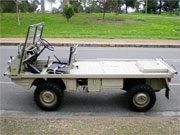
|
The vehicle shown to the left is a very nice example of an Australian LWB Haflinger. There are no rear boards or hoodsticks, as the vehicle also has an Australian made full hardtop (see further below).
Das links gezeigte Fahrzeug ist ein schönes Beispiel für einen Australischen 703 AP. Bordwände und Planengestänge sind nicht vorhanden, da der Haflinger auch einen
Aufbau aus Australischer Produktion besitzt (siehe weiter unten).
|
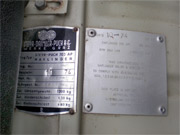
|
In the late years, Haflingers in Australia had to be fitted with an extra Australian Design Rules (ADR) compliance plate next to the Steyr-Puch type plate.
In den späten Verkaufsjahren mussten die Haflinger in Australien mit einem extra "Australian Design Rules" (ADR) Typenschild ausgesttattet werden.
|
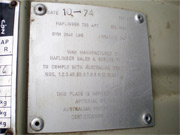
|
Here you see a close up of the ADR compliance plate. The Australian Design Rules were also responsible for higher prices, as Haflingers had to be fitted with laminated windscreens, seat belts etc. to
comply with the ADR specifications.
Hier eine Nahaufnahme des Typenschilds. Die Australischen Spezifikationen waren auch verantwortlich für höhere Preise, da die Haflinger z.B. mit laminierten Windschutzscheiben,
Sitzgurten usw. ausgestattet werden mussten.
|
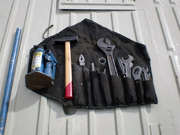
|
Even the original set of tools is still there, with the late, hydraulic lifting jack.
Sogar der originale Werkzeugsatz mit dem späten, hydraulischen Wagenheber ist bei diesem Haflinger noch vorhanden.
|
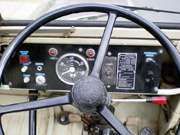
|
Note the plastic bonded steering wheel, which was only fitted to very late Haflingers.
Man beachte das plastikummantelte Lenkrad, das nur noch bei sehr jungen Haflingern verbaut wurde.
|
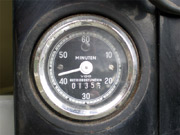
|
Close-up of the engine hour meter next to the dashboard.
Nahaufnahme des Betriebsstundenzählers neben dem Armaturenbrett.
|
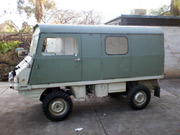
|
On this picture you can see the full hardtop - it gives the Haflinger a very different look! Thanks Edward Cleland for the pictures.
Auf diesem Bild ist der Aufbau zu sehen - interessant, wie sich dadurch das gesamte Aussehen des Haflingers ändert.
|
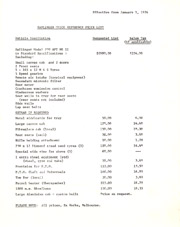
|
Another price list, dated January 1974. Note that the price for the basic vehicle has risen about 34 per cent compared to the 1970 price list.
Eine weitere Preisliste vom Jänner 1974. Der Preis für das Grundfahrzeug ist im Vergleich zu 1970 um 34 Prozent gestiegen.
|
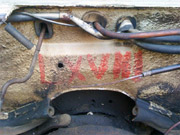
|
Here you see one more interesting detail from one of Rick Krassoi's Haflingers: There are roman numerals on the front wall of the engine room...
Hier noch ein interessantes Detail von einem von Rick Krassoi's Haflingern: Römische Ziffern finden sich sowohl auf dem vorderen Blech des Motorraums,...
|
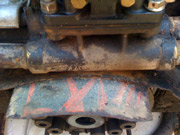
|
...and on the engine itself. Possibly there was a special number system to ensure that the right CKD components would be put together. On the assembly line picture, you can also see a number on the first Haflinger.
...als auch auf dem Motor selbst. Vermutlich war das ein spezielles Nummernsystem, damit die CKD-Kits wieder richtig zusammengesetzt wurden. Auf dem Bild mit der Produktionslinie sieht man auch Römische Ziffern am ersten Haflinger.
|
US Haflingers in Australia
Quite a lot of vehicles that were initially produced for the U.S. market in 1972 were, for some reason, not exported there any more. The Haflingers were waiting for other buyers at Graz
and then finally sold to customers in Europe - and in Australia! For this reason, one can still find some "Pathfinder" version Haflingers over there. The vehicles were converted to
right hand drive at Graz and then sent to Australia as CKD kits in 1974.
Viele Fahrzeuge, die Steyr-Puch 1972 eigentlich für die USA produzierte, wurden nicht mehr dorthin ausgeliefert. Die Haflinger wurden schlussendlich in Europa und auch in Australien verkauft.
Aus diesem Grund findet man dort auch heute noch einige "Pathfinder"-Modelle. Die Haflinger wurden 1974 in Graz zu Rechtslenkern umgerüstet und als CKD-Kits nach
Australien verschickt.
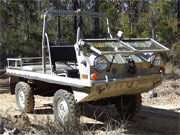
|
Here you see a beautiful example of an Australian US-Haflinger, owned by Rick Krassoi. Note that the vehicle was also fitted with tropical air intake, as usual for Australia.
Hier ein tolles Beispiel für einen Australischen US-Haflinger von Rick Krassoi. Das Fahrzeug wurde auch mit dem Tropenluftfilter ausgestattet, wie üblich in Australien.
|
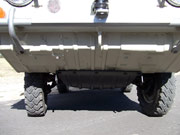
|
The front footwell shows that the vehicle was once thought to be left hand drive. The original reinforcement panel for the steering assembly is still on the left side.
Die Fußwanne zeigt, dass der Haflinger einmal linksgelenkt war. Das Verstärkungsblech für die Lenkung ist noch immer auf der linken Seite.
|
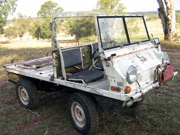
|
This picture shows a US model Haflinger that was used as a street sweeper vehicle.
Dieses Bild zeigt einen US-Haflinger, der für die Straßenreinigung eingesetzt wurde.
|

|
The green Haflinger to the left was located in Western Australia. Note that this Haf still has the US rear lights assembly with side markers. Thanks Gary Stanway for the pictures.
Der links abgebildete grüne Haflinger war in Westaustralien zu Hause. Man beachte, dass dieses Fahrzeug auch noch die US-spezifischen Rücklichter mit Seitenmarkierungsleuchten besitzt. Danke Gary Stanway für die Bilder.
|
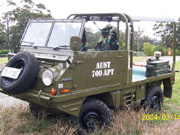
|
Here you see the same vehicle after restoration. Sadly, I don't know what happened with the vehicle since it was sold.
Hier das selbe Fahrzeug nach der Restauration. Leider weiß ich nicht, was nach dem Verkauf aus dem Haflinger geworden ist.
|
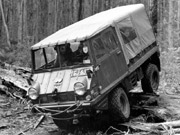
|
The picture to the left was taken years ago and shows another nice "Pathfinder" model. Thanks Peter Farrer for the photo.
Dieses Bild wurde vor Jahren aufgenommen und zeigt einen weiteren schönen "Pathfinder". Danke Peter Farrer für das Foto.
|
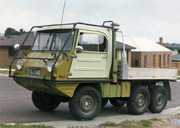
|
Finally a picture of a US Haflinger with a third, lazy axle. Sadly, I have no details about the conversion. Note again the Australian Polycab! Thanks Peter Farrer for the picture.
Zu guter letzt noch ein Bild von einem US-Haflinger mit einer dritten, nicht angetriebenen Achse. Leider kenne ich keine Details zum Umbau. Danke Peter Farrer für das Foto.
|
Usage of Haflingers in Australia
In this chapter, I'd like to show some interesting pictures of how Haflingers were used in Australia. The main group of buyers would probably have been farmers. However Haflingers were,
for example, also used by mining companies and governmental organizations (e.g. vehicles for street sweeping etc.). I hope to be able to publish more photos here soon.
In diesem Kapitel würde ich gerne interessante Fotos zeigen, die dokumentieren, wie Haflinger in Australien verwendet wurden. Die Hauptgruppe von Käufern waren wahrscheinlich
Farmer, aber Haflinger wurden auch von Bergbaufirmen und Regierungsbetrieben angekauft (z.B. für die Straßenreinigung usw.). Ich hoffe, dass ich hier bald noch mehr Bilder zeigen kann.
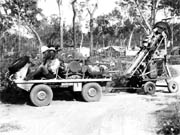
|
This picture shows an Australian Haflinger, possibly used by a mining company. I must admit that I don't really know what the equipment would be good for. Thanks Dr. Rudolf for the picture.
Dieses Foto zeigt einen Australischen Haflinger, wahrscheinlich im Dienst eines Bergbaubetriebes. Ich muss jedoch zugeben, dass ich nicht wirklich weiß, wofür die Ausrüstung gut ist.
|
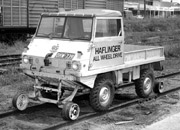
|
This Haflinger was used on a railway in Queensland. The label on the windscreen says 1975. Any closer info would be much appreciated! Thanks Malcolm Gillot for the pictures.
Dieser Haflinger war bei einer Eisenbahn in Queensland im Einsatz. Laut der Plakette auf der Windschutzscheibe dürfte das Foto 1975 aufgenommen worden sein. Danke Malcolm Gillot für die Bilder.
|
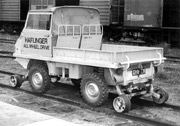
|
Same vehicle from the rear.
Das selbe Fahrzeug von hinten gesehen.
|
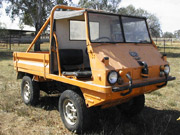
|
The orange Haflinger to the left was used by the Australian Telecom.
Der links gezeigte orange Haflinger war früher im Einsatz bei der Australischen Telekom.
|
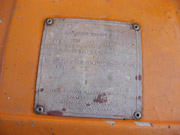
|
Again you find the ADR compliance plate, in this case a slightly older version than above.
Dieser Haflinger ist wiederum mit einem ADR Typenschild ausgestattet, allerdings eine etwas ältere Version als weiter oben.
|
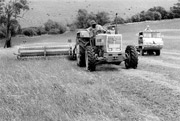
|
Haflinger and Steyr Tractor working together on a farm in Australia. Thanks John Callahan for the picture.
Haflinger und Steyr Traktor arbeiten zusammen auf einer Farm in Australien. Danke John Callahan für das Bild.
|
Links
|
Australian Army Haflinger |

|
|
Overlander Magazine 10/1977 |

|
|
New Australian Haflinger Club Website |

|
|
Peter Farrer's Website |

|
|
David Clark's Website |

|
Comments
Here is, where your part of the page begins! If you have anything to contribute, feel free to
add a comment!
5 of 16 existing comments are shown here. Please click to
show them all.
 |
 |
|
Sorry I should have put that the three haflingers are for sale as we need to clean up the site..location is Armidale NSW. Contact 0458991552 . Possibility of more parts not yet found...
|
 |
 |
|
Deceased estate 3 haflingers .been outside two are shells one is on wheels found its motor inside the house lots of parts including all the doors plus ..
|
 |
 |
Great site!
I just bought a '69 Haflinger from a friend who used it on his farm in Gippsland, Victoria. Apparently it was used by two girls to drive to Monash University (It still has the 1973 and 74 parking permits on the windscreen). Then used on their family farm for the next 40 yrs where it was always garaged. It received a new motor, Dynastart and brakes in 2011. It looks like someone was restoring it, but was sold at a classic car auction in 2012 to my friend. He is moving from the farm so I bought it from him. As it has always been garaged it has no rust and is in quite good original condition. It has the PTO and only one rear footwell. I hope to register it and use it for weekend Cafe runs :-)
|
 |
 |
|
Great website!!! Very informative. I love Haffies, I hope to own one someday but for now I'm having lots of fun with my 1985 Australian delivered civilian 712K. We play all over the Victorian High country and occasionally a little beyond
|
 |
 |
I got a very nice 1974 Haflinger 700ap SWB MK II from your Country. The first Owner is Peter,He own this small off road machine since 30 year ago.The car Reg No. is AP-700 He also got a Land Rover FC 101 6x6 prototype, ( it is a power trailer to make it 6x6.)
2003 this car export to Hong Kong, I use 2 year to reg this car in our city,Reg No. in HK is AB 156, Today this vehicle been fully rebuild at my work shop.This is the only one haflinger in HK now. at early 60-70s HK police and fire Dept use a little Haflinger 703 LWB.If you have any complete 5 speed chassis, please tell me, I need a spare chassis as spare parts. my e mail address haflinger700ap@yahoo.com
or go to www.4wdco.com Co collection to see this little off road machine.
|
|



































































